Do you want your child to cook for you? Christmas biscuits perhaps, or dinner being made as you sit with your feet up? You can make a start sooner than you think. Toddlers love to get involved, learn new words in their main language or another one they speak, and use their senses, especially to taste the final result. They learn through play. At first it will be a joint project, and you’ll have to accept a lot of mess as part of the experience. And invest a lot of time. Attention! Toddler in the kitchen.
Baking is the easiest, because it doesn’t involve boiling liquids and frying things on the hob. Savoury dishes can come later. There are loads of books with ideas for baking with children. Your child might also enjoy following a recipe in a “grown up” cook book. At the same time, stay healthy and use Lucy Thomas’s “Mange Tout” to get them eating vegetables, as in my blog post “Fun, multilingual ways to get kids eating vegetables.” There’s a great website devoted to teaching kids languages through cooking: “Cooking with Languages”. There’s also my recent blog post “Baking with languages: kids learn as they cook”.
When my daughter was born a colleague wrote: “Enjoy her, they grow so quickly.” So make the most of every age and every stage. When my baby was 2 weeks old my husband went back to work and we managed to get to the local “Bumps and Babes” group for about half an hour. The get-together started at 11 am, and it was a struggle to get ready in time. What took so long? Hard to imagine now. Perhaps it was fitting everything in around feeding and changing, then it was time to feed and change again. As we were leaving the house there was a nappy incident. I trudged back upstairs and put my daughter in the bath. We both relaxed as I realized that there was a different pace to life now and..… go with the flow. The new lifestyle.
When you’re a toddler, “helping Mummy/Daddy” in the kitchen is fun, you chat, you learn about all sorts of things and you feel proud. Of course it will take Mummy/Daddy longer than it would do normally. My toddler used to help me sort out the washing: identify colours, find the shirts, pair the socks. Here she is, doing a bit of washing up

The kitchen was the engine room of the house, but the engine was slow. She’d bounce in her bouncer, when older she’d sit in her high chair, and we’d chat and sing while I cooked. I was used to recording kids’ communication from my job as a teacher of deaf children, so lots of interesting conversations were scribbled down on a notepad next to the fridge. Advice came from my experienced friend Adele: “Write down what she says. You think you will remember, but you don’t.”
Getting messy was part of the fun. We’d paint and sculpt in the kitchen, even expanding into the garden, and even in winter.
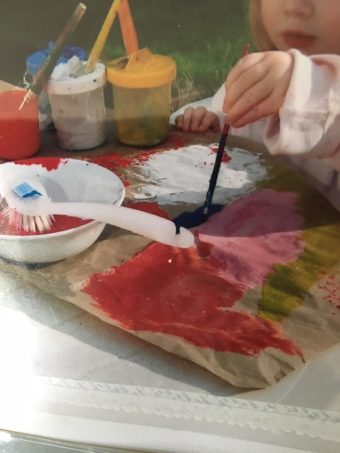
A lovely finger painting mess on the kitchen table
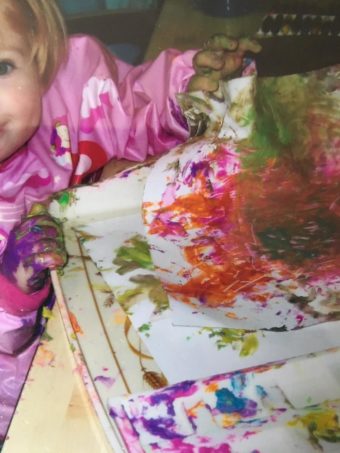
and here, she’s a bit older. If you look closely you can spot flowers, a bee and some carrot and hand printing
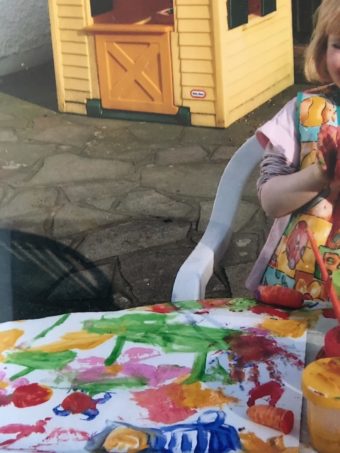
about the same age, some foot printing on the kitchen floor

When my toddler was about 18 months old we used to go to the Messy Monsters art group. There she enjoyed painting her feet red and her hair green. I enjoyed the envious comments from passers-by as we walked home. Adults would secretly love to paint, play and make a mess again. After all, you can always clean up afterwards. For me, having taught nursery and reception classes was a great preparation. Especially as Wednesday afternoons had been cooking afternoons. In the kitchen at home, the more mess, the more fun – within reason. Wise words came from a fellow translator: “Whisper this very quietly, so nobody can hear – this is a chance for you to play too, before they go to school.”
There’s the crawling stage, and shortly after that there’s the going-in-cupboards stage, when you have to fix special locks on the doors in your kitchen and they’re still there years later. We left one floor-level cupboard with no locks. It was full of old pans, wooden spoons, plastic containers and they would end up all over the floor and facilitate a lot of noise. Very satisfying. This was a low-key version of an idea I read in a book, which suggested leaving plastic bowls, spoons, whisk, flour, water, oats and other interesting things on the kitchen floor, along with your toddler. “There! Now you can make that ‘phone call you’ve been trying to make all day.”
At the age of 2 it was time to start baking together – a simple wholemeal bread mixture. Great smells – yeast, bread in the oven – and textures. Your hands get all sticky. Toddlers love to mix with their hands, knead and shape the dough.
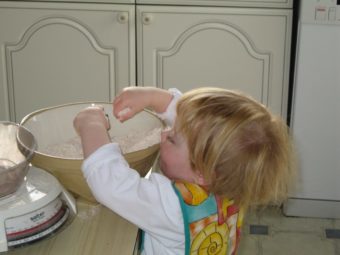
One conversation went like this:
“Apwon! Mummy apwon too!”
“Fyour IN.”
Me: “Where shall we put it now?”
“Baffwoom” [airing cupboard, to rise]
Me: “What will happen?” [spot the teacher]
“Go UP.”
In my archive post “I’ll tell you what I want” there are some snippets from our developing conversations over the next few years.
By age 2 and a half she could remind me of all the ingredients before getting started.
At age 3 we introduced fruit crumble to our baking range. A friend was coming for dinner and we were making desert. My toddler was dying to plunge her hands into the bowl and make a fantastic mess converting the butter, flour and sugar into crumble. We had two attempts at this, as the first mixture had to be condemned. Whilst I was distracted preparing the fruit mixture, my toddler had been busy mixing bits of orange playdough into the crumble mixture, which made it more interesting to look at but less appealing to eat. She was keen to tuck into our second attempt: “It’s taking a long time for Bob to come”. Bob became associated with hearty puddings (“Bob comes round for crumble”). I later wondered what he and Daddy would be eating when they went out for dinner and her verdict was: “Pie and sponge pudding.” Here’s my daughter making crumble. The paint pots in the background are dangerously close.
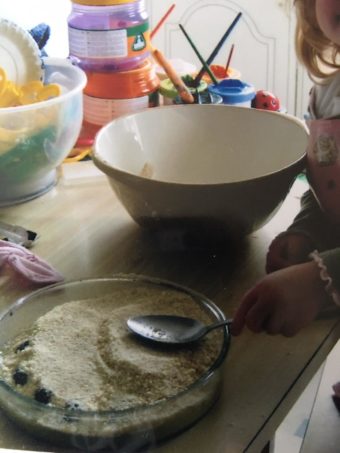
Every nursery teacher and parent knows how tricky scissors are for pre-schoolers. It’s the sort of skill we take for granted because we learnt it so long ago, like tying shoe laces. I gave our daughter a pile of cold cooked spaghetti and some play scissors. After several attempts she gave up: “I can’t do it. I’ll eat it instead.”
Invite your retired neighbour round for scones in the afternoon. Then everyone’s a winner. My toddler was proud of our “scones for Joyce.” And she recognized my contribution too: “You’re a great cooker, Jane.”
Moving on from toddlerhood, you can carry on baking delicious bread, and you can try some new recipes. By age 4 we had a repertoire of special biscuits and cakes, including a ginger bread house. You can buy kits, but it’s easy to make a house from scratch, using baking paper to make templates for the walls and roof. The decorating part is really fun.
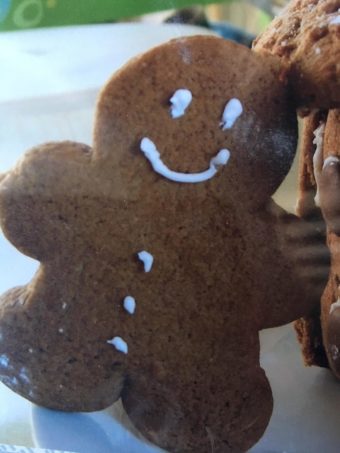
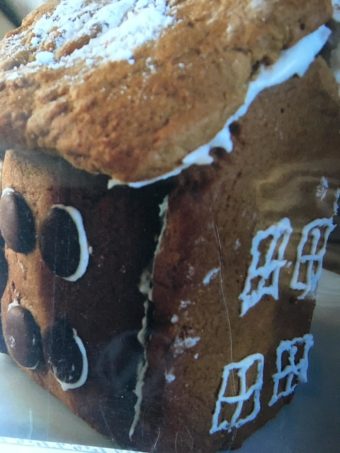
You can chat about what you’re doing, what it looks like, feels like and smells like. This probably counts as being “mindful”, and anyway rediscovering things is part of the “parenting adventure”.
Biscuits are fun
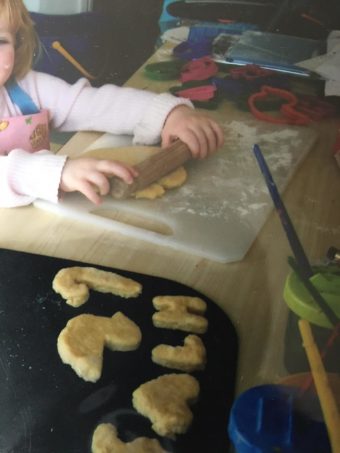
and different types of buns
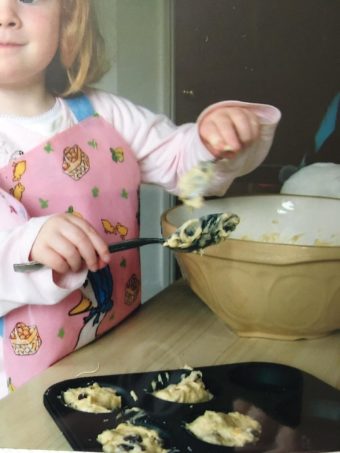
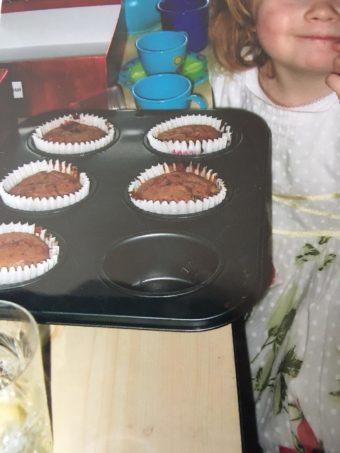
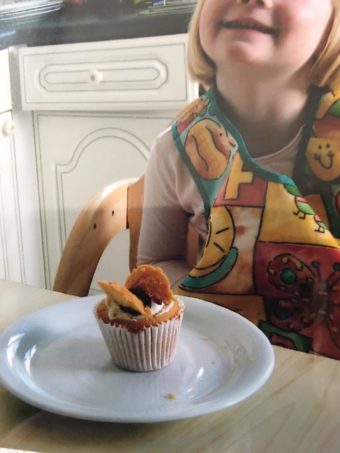
“When I will have smelled the cake, then it will be ready.” This is an accurate observation, and a good gauge to use when you’ve forgotten to set the oven timer. For those of us who like linguistics, it’s an interesting use of the future perfect tense.
You might have a baking birthday party for your child and help a small group of their friends to make something special to take home with them. We made fairy cakes. You can buy kids’ paper chefs’ hats and aprons.

You never know, you might have started a cooking passion for life, and in a few years’ time your 12 year-old might choose a recipe and make dinner for the family all by him or herself. Your very own chef. The difference now is that you hope for less mess.

Leave a Reply